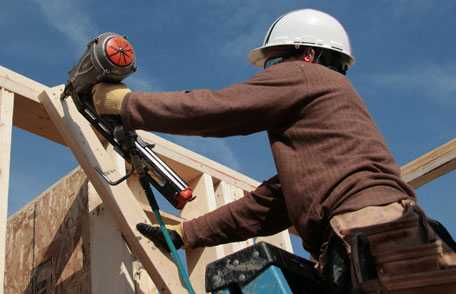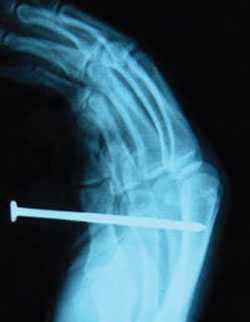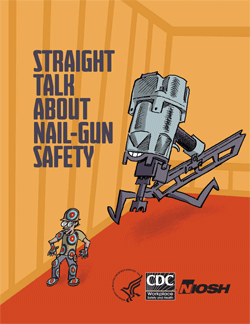Nailing Down the Need for Nail Gun Safety
 Nail guns are used every day in many construction jobs and in homes and cause tens of thousands of painful injuries each year. Get the latest information on nail gun hazards and practical advice you should take to prevent injuries at your job site.
Nail guns are used every day in many construction jobs and in homes and cause tens of thousands of painful injuries each year. Get the latest information on nail gun hazards and practical advice you should take to prevent injuries at your job site.
The Reality
Nail guns are powerful, easy to operate, and boost productivity for nailing tasks. They are also responsible for an estimated 37,000 emergency room visits each year – 68% of these involve workers and 32% involve consumers. Severe nail gun injuries have led to construction worker deaths. Fortunately, these injuries can be prevented, and more and more contractors are making changes to improve nail gun safety. Research shows that risk of injury is twice as high using "contact" trigger nail guns compared to "sequential" trigger nail guns.

Nail gun injuries are responsible for an estimated 37,000 emergency room visits each year.
How do Nail Gun Injuries Happen?
There are seven major risk factors that can lead to nail gun injury. Understanding them will help you to prevent injuries on your job sites.
- Unintended nail discharge from double fire;
- Unintended nail discharge from knocking the safety contact with the trigger squeezed;
- Nail penetration through lumber work piece;
- Nail ricochet after striking a hard surface or metal feature;
- Missing the work piece;
- Awkward position nailing; and
- Bypassing safety mechanisms.
It Can Happen to You
Here are two stories of nail gun injuries that hammer home the issue of nail gun safety.
From a construction worker's standpoint:
Two framers were working together to lay down and nail a subfloor. One framer was waiting and holding the nail gun with his finger on the contact trigger. The other framer was walking backwards toward him and dragging a sheet of plywood. The framer handling the plywood backed into the tip of the nail gun and was shot in the back. The nail nicked his kidney, but fortunately he recovered. As a result of this incident, the contractor switched to using only sequential triggers on framing nail guns. Co-workers can get injured if they bump into your contact trigger nail gun. You can prevent this by using a full sequential trigger.
From a contractor's standpoint:
After his crews experienced many double fires and a related serious nail gun injury, a New Jersey contractor switched to using only sequential triggers. He believes he has eliminated the risk of double fire injuries and he estimates that the change has had only a slight impact on productivity—a few extra hours per house.

A comic book based on NIOSH supported research, Nail Gun Safety: A Guide for Construction Contractors
6 Practical Steps You Can Take
By taking these steps, employers can prevent nail gun injuries from occurring:
- Use full sequential trigger nail guns;
- Provide training;
- Establish nail gun work procedures;
- Provide personal protective equipment (PPE);
- Encourage reporting and discussion of injuries and close calls; and
- Provide first aid and medical treatment.
Two new documents strive to help prevent nail gun injuries and keep construction workers and consumers safe. The first, "Nail Gun Safety: A Guide for Contractors," developed by the National Institute of Occupational Safety and Health (NIOSH) and the Occupational Safety and Health Administration (OSHA), was developed for contractors. The second, "Straight Talk About Nail Gun Safety," is worker-focused.
More Information
- Page last reviewed: November 4, 2016
- Page last updated: November 4, 2016
- Content source:
- National Institute for Occupational Safety and Health
- Page maintained by: Office of the Associate Director for Communication, Digital Media Branch, Division of Public Affairs




 ShareCompartir
ShareCompartir